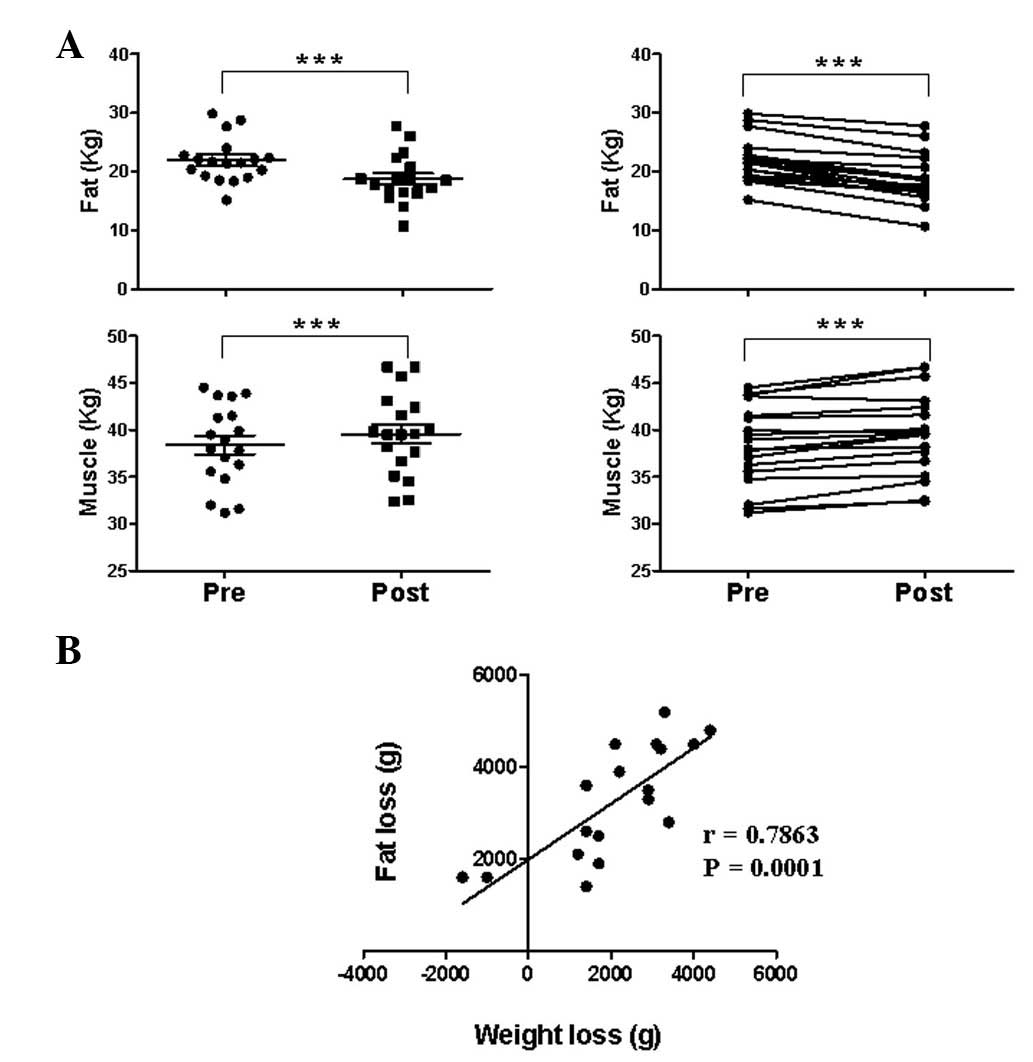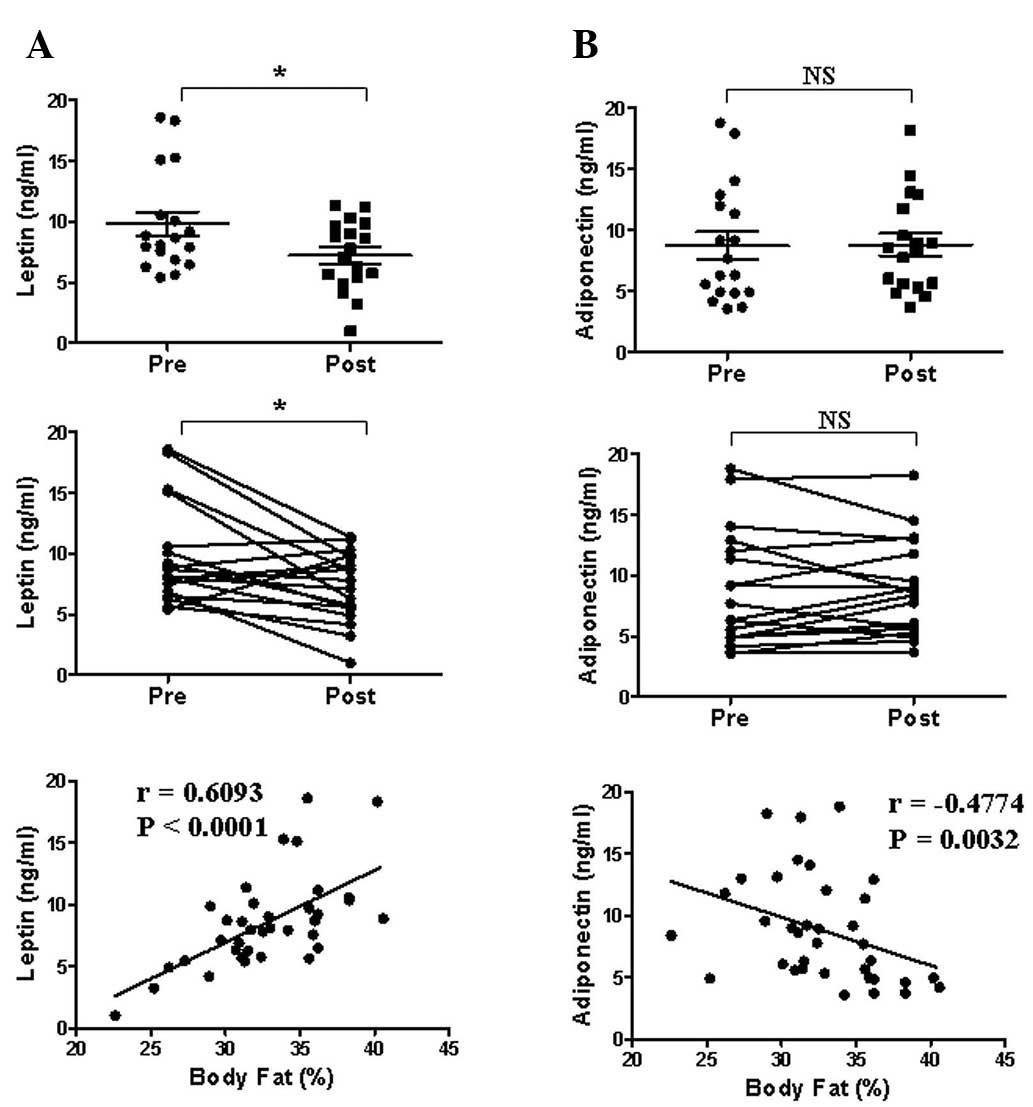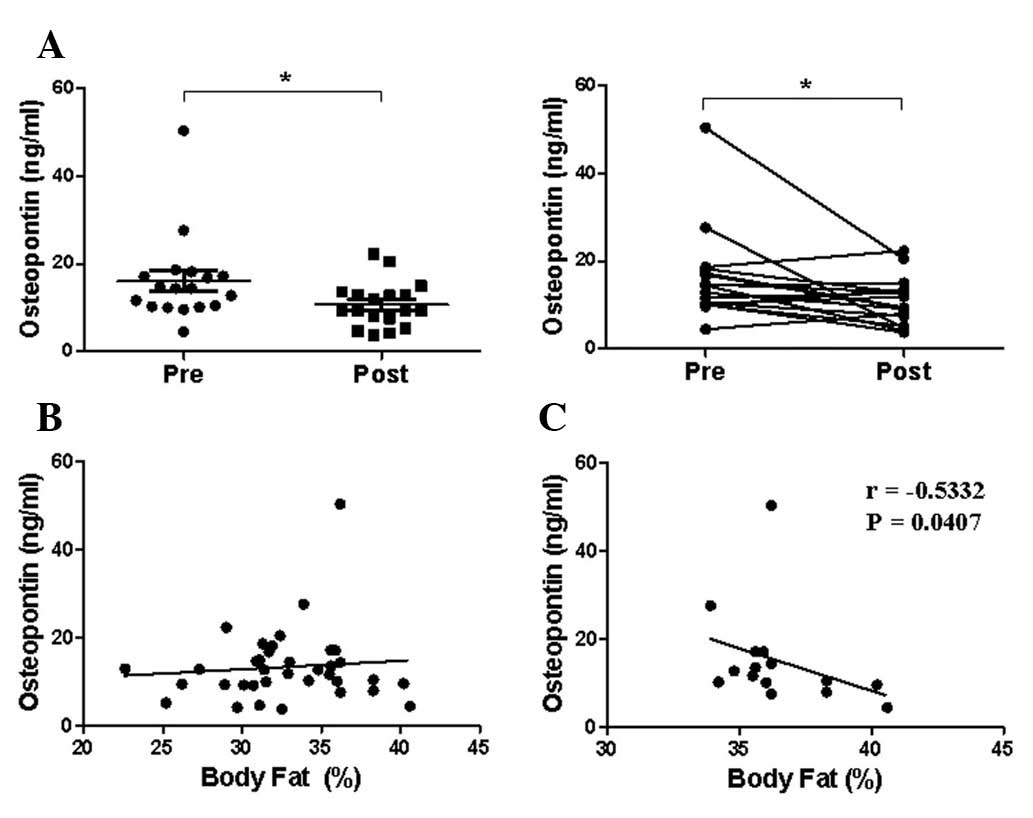|
1
|
Harford KA, Reynolds CM, McGillicuddy FC
and Roche HM: Fats, inflammation and insulin resistance: insights
to the role of macrophage and T-cell accumulation in adipose
tissue. Proc Nutr Soc. 70:408–417. 2011. View Article : Google Scholar : PubMed/NCBI
|
|
2
|
Morimoto J, Kon S, Matsui Y and Uede T:
Osteopontin; as a target molecule for the treatment of inflammatory
diseases. Curr Drug Targets. 11:494–505. 2010. View Article : Google Scholar : PubMed/NCBI
|
|
3
|
Nomiyama T, Perez-Tilve D, Ogawa D, et al:
Osteopontin mediates obesity-induced adipose tissue macrophage
infiltration and insulin resistance in mice. J Clin Invest.
117:2877–2888. 2007. View
Article : Google Scholar : PubMed/NCBI
|
|
4
|
Kiefer FW, Zeyda M, Todoric J, et al:
Osteopontin expression in human and murine obesity: extensive local
up-regulation in adipose tissue but minimal systemic alterations.
Endocrinology. 149:1350–1357. 2008. View Article : Google Scholar
|
|
5
|
Gómez-Ambrosi J, Catalán V, Ramírez B, et
al: Plasma osteopontin levels and expression in adipose tissue are
increased in obesity. J Clin Endocrinol Metab. 92:3719–3727.
2007.PubMed/NCBI
|
|
6
|
Xu G, Sun W, He D, et al: Overexpression
of osteopontin in rheumatoid synovial mononuclear cells is
associated with joint inflammation, not with genetic polymorphism.
J Rheumatol. 32:410–416. 2005.PubMed/NCBI
|
|
7
|
Braitch M and Constantinescu CS: The role
of osteopontin in experimental autoimmune encephalomyelitis (EAE)
and multiple sclerosis (MS). Inflamm Allergy Drug Targets.
9:249–256. 2010. View Article : Google Scholar : PubMed/NCBI
|
|
8
|
Frenzel DF and Weiss JM: Osteopontin and
allergic disease: pathophysiology and implications for diagnostics
and therapy. Expert Rev Clin Immunol. 7:93–109. 2011. View Article : Google Scholar : PubMed/NCBI
|
|
9
|
Waller AH, Sanchez-Ross M, Kaluski E and
Klapholz M: Osteopontin in cardiovascular disease: a potential
therapeutic target. Cardiol Rev. 18:125–131. 2010. View Article : Google Scholar : PubMed/NCBI
|
|
10
|
Naldini A, Leali D, Pucci A, et al:
Cutting edge: IL-1beta mediates the proangiogenic activity of
osteopontin-activated human monocytes. J Immunol. 177:4267–4270.
2006. View Article : Google Scholar : PubMed/NCBI
|
|
11
|
Rangaswami H, Bulbule A and Kundu GC:
Osteopontin: role in cell signaling and cancer progression. Trends
Cell Biol. 16:79–87. 2006. View Article : Google Scholar : PubMed/NCBI
|
|
12
|
Kiefer FW, Neschen S, Pfau B, et al:
Osteopontin deficiency protects against obesity-induced hepatic
steatosis and attenuates glucose production in mice. Diabetologia.
54:2132–2142. 2011. View Article : Google Scholar : PubMed/NCBI
|
|
13
|
Zeyda M, Gollinger K, Todoric J, et al:
Osteopontin is an activator of human adipose tissue macrophages and
directly affects adipocyte function. Endocrinology. 152:2219–2227.
2011. View Article : Google Scholar : PubMed/NCBI
|
|
14
|
Komorowski J, Jankiewicz-Wika J, Kolomecki
K, et al: Systemic blood osteopontin, endostatin, and E-selectin
concentrations after vertical banding surgery in severely obese
adults. Cytokine. 55:56–61. 2011. View Article : Google Scholar
|
|
15
|
Schaller G, Aso Y, Schernthaner GH, et al:
Increase of osteopontin plasma concentrations after bariatric
surgery independent from inflammation and insulin resistance. Obes
Surg. 19:351–356. 2009. View Article : Google Scholar : PubMed/NCBI
|
|
16
|
Shevde LA, Das S, Clark DW and Samant RS:
Osteopontin: an effector and an effect of tumor metastasis. Curr
Mol Med. 10:71–81. 2010. View Article : Google Scholar : PubMed/NCBI
|
|
17
|
Giachelli CM and Steitz S: Osteopontin: a
versatile regulator of inflammation and biomineralization. Matrix
Biol. 19:615–622. 2000. View Article : Google Scholar : PubMed/NCBI
|
|
18
|
Reinholt FP, Hultenby K, Oldberg A and
Heinegård D: Osteopontin - a possible anchor of osteoclasts to
bone. Proc Natl Acad Sci USA. 87:4473–4475. 1990. View Article : Google Scholar : PubMed/NCBI
|
|
19
|
Friedewald WT, Levy RI and Fredrickson DS:
Estimation of the concentration of low-density lipoprotein
cholesterol in plasma, without use of the preparative
ultracentrifuge. Clin Chem. 18:499–502. 1972.PubMed/NCBI
|
|
20
|
Sowers MR and Karvonen-Gutierrez CA: The
evolving role of obesity in knee osteoarthritis. Curr Opin
Rheumatol. 22:533–537. 2011. View Article : Google Scholar : PubMed/NCBI
|
|
21
|
Shehzad A, Ha T, Subhan F and Lee YS: New
mechanisms and the anti-inflammatory role of curcumin in obesity
and obesity-related metabolic diseases. Eur J Nutr. 50:151–161.
2011. View Article : Google Scholar : PubMed/NCBI
|
|
22
|
Trayhurn P and Wood IS: Adipokines:
inflammation and the pleiotropic role of white adipose tissue. Br J
Nutr. 92:347–355. 2004. View Article : Google Scholar : PubMed/NCBI
|
|
23
|
Wärnberg J, Cunningham K, Romeo J and
Marcos A: Physical activity, exercise and low-grade systemic
inflammation. Proc Nutr Soc. 69:400–406. 2010.PubMed/NCBI
|
|
24
|
Gleeson M, Bishop NC, Stensel DJ, et al:
The anti-inflammatory effects of exercise: mechanisms and
implications for the prevention and treatment of disease. Nat Rev
Immunol. 11:607–615. 2011. View
Article : Google Scholar : PubMed/NCBI
|
|
25
|
Klempel MC and Varady KA: Reliability of
leptin, but not adiponectin, as a biomarker for diet-induced weight
loss in humans. Nutr Rev. 69:145–154. 2011. View Article : Google Scholar : PubMed/NCBI
|
|
26
|
Frühbeck G, Gómez-Ambrosi J, Muruzábal FJ
and Burrell MA: The adipocyte: a model for integration of endocrine
and metabolic signaling in energy metabolism regulation. Am J
Physiol Endocrinol Metab. 280:E827–E847. 2001.PubMed/NCBI
|
|
27
|
Arita Y, Kihara S, Ouchi N, et al:
Paradoxical decrease of an adipose-specific protein, adiponectin,
in obesity 1999. Biochem Biophys Res Commun. 31:560–564.
2012.PubMed/NCBI
|
|
28
|
Shehzad A, Iqbal W, Shehzad O and Lee YS:
Adiponectin: regulation of its production and its role in human
diseases. Hormones (Athens). 11:8–20. 2012.PubMed/NCBI
|
|
29
|
Guerre-Millo M: Adiponectin: an update.
Diabetes Metab. 34:12–18. 2008. View Article : Google Scholar
|
|
30
|
Riedl M, Vila G, Maier C, et al: Plasma
osteopontin increases after bariatric surgery and correlates with
markers of bone turnover but not with insulin resistance. J Clin
Endocrinol Metab. 93:2307–2312. 2008. View Article : Google Scholar : PubMed/NCBI
|
|
31
|
Humphries B, Fenning A, Dugan E, et al:
Whole-body vibration effects on bone mineral density in women with
or without resistance training. Aviat Space Environ Med.
80:1025–1031. 2009. View Article : Google Scholar : PubMed/NCBI
|
|
32
|
Smith EL and Gilligan C: Physical activity
effects on bone metabolism. Calcif Tissue Int. 49(Suppl): S50–S54.
1991. View Article : Google Scholar
|
|
33
|
Reis CE, Bressan J and Alfenas RC: Effect
of the diet components on adiponectin levels. Nutr Hosp.
25:881–888. 2010.PubMed/NCBI
|
|
34
|
Tamura A, Shingai M, Aso N, et al:
Osteopontin is released from the heart into the coronary
circulation in patients with a previous anterior wall myocardial
infarction. Circ J. 67:742–744. 2003. View Article : Google Scholar : PubMed/NCBI
|
|
35
|
Oh KW, Lee WY, Rhee EJ, et al: The
relationship between serum resistin, leptin, adiponectin, ghrelin
levels and bone mineral density in middle-aged men. Clin Endocrinol
(Oxf). 63:131–138. 2005. View Article : Google Scholar : PubMed/NCBI
|
|
36
|
Villareal DT, Fontana L, Weiss EP, et al:
Bone mineral density response to caloric restriction-induced weight
loss or exercise-induced weight loss: a randomized controlled
trial. Arch Intern Med. 166:2502–2510. 2006. View Article : Google Scholar : PubMed/NCBI
|

















